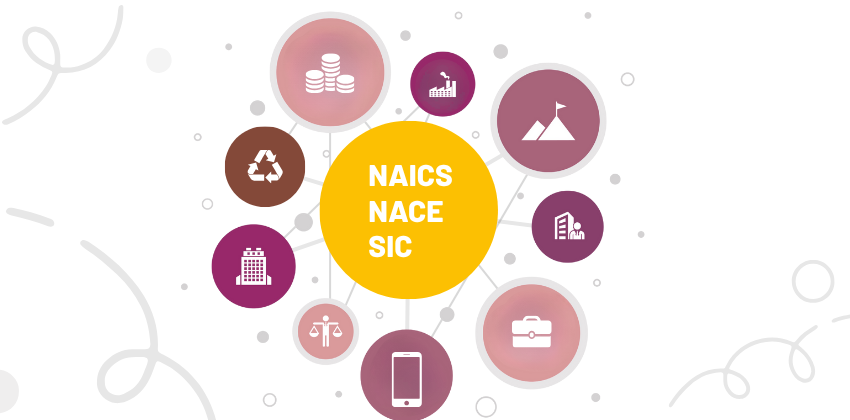NACE, SIC and NAICS: what they are and what are the differences
International classification of productive activities: what are NACE, SIC and NAICS and where to find them

NACE, SIC and NAICS: what they are and what are the differences International classification of productive activities: what are NACE, SIC and NAICS and where to find them
NACE, SIC and NAICS are international systems for the classification of economic activities: created to standardize data and information for statistical and market purposes, these codes particularly identify companies in Europe and North America.
NACE is very different from the codes used in the United States, Mexico and Canada: in its national implementation, this code is officially assigned to all economic entities operating in Europe, and is therefore considered public and accessible information. NAICS, on the other hand, which replaced SIC, is widely used for statistics and market analysis but is not unique: each entity can assign one code or another to companies, based on its own assessment.
NACE Code: what it is and what it is used for
NACE is the acronym of Nomenclature statistique des Activités économiques dans la Communauté Européenne (in English: Statistical Classification of Economic Activities in the European Community). It is the common standard adopted in the European Union countries to classify economic activities within a uniform framework that allows the collection and transmission of statistical data at national and community level.
The purpose of the NACE code is to identify as precisely as possible the economic activities that make up the productive fabric of the European Union – for statistical purposes but also to identify companies in bureaucratic or administrative contexts.
The nomenclature was introduced by Eurostat in 1970, and has been amended several times over the years. The currently applicable version is Revision 2.1, contained in EU Regulation 2023/137, which came into force in 2023 and is officially in use from January 1, 2025.
Difference between NACE code and Ateco
The Ateco code is the Italian version of the NACE code. The main difference is that while the NACE classification identifies activities at the European level, the Ateco code is adapted to reflect the specific features of the Italian economy and provides a greater level of detail.
For example, NACE code 56.11 (Restaurant Activities) in Italy is broken down into 12 different Ateco codes, ranging from ice cream parlors with table service (56.11.21) to catering activities linked to farms (56.11.91) – which at the European level are all included under NACE 56.11.
This correspondence can be found in the comparative table provided by Istat on its website, which includes the list of NACE REV 2.1 codes and the related Italian Ateco 2025 classification.
Since the Ateco classification is embedded in the national economic context, it can describe in greater detail the economic activities operating in Italy. Therefore, Chambers of Commerce, the Revenue Agency and other entities refer to these codes.
SIC Code: what it is and where it is used
Outside Europe, companies are defined through other codes: one of the most widespread and important to know is the SIC (Standard Industrial Classification), used in North American countries and in Great Britain.
SIC was created in the 1930s to provide the United States government with a standard to measure and analyze data relating to national economic activities. In 1997 it was replaced by NAICS, which combines the standards of the USA, Canada and Mexico and provides a more accurate description of activities. However, it is still used by various organizations.
A different matter applies to the SIC used in Great Britain, which is an adaptation of the American code aligned with European standards (i.e. NACE). Unlike the US one, the UK SIC is assigned by the Companies House and is still the reference code for describing economic activities. It consists of 5 digits and is not interchangeable with the US SIC, which instead has 4 digits.
SIC Code: where to find it?
As the official reference for UK business, equivalent to the Ateco code in Italy, the list of SIC codes is held within the Companies House business register. It is therefore a matter of public interest and can easily be consulted online using the service provided by the government.
As for the US SIC, the matter is more complex: first of all because the United States does not have a unified national register, and also because this code, having been replaced, is no longer assigned by federal agencies.
Nevertheless, it is still a nomenclature used in various contexts, which is why it can be found both in statistics and in company reports.
NAICS Code: what it is and the differences with the SIC code
The NAICS (North American Industry Classification System) code, as mentioned, represents the evolution of the US SIC code. The first major difference is that this new system, officially adopted in 1997, goes beyond national borders by harmonizing the classification of economic activities in USA, Mexico and Canada.
The second substantial difference is that NAICS is much more detailed, since it does not rely on production and demand, as SIC did, but classifies companies based on production processes.
Unlike NACE and Ateco, the two US codes have no correspondence: for example, SIC code 5192 (Books, periodicals and newspapers) corresponds to NAICS codes 424920 (Wholesale of books, periodicals and newspapers), 425110 (B2B electronic markets), 425120 (Wholesale trade agents and brokers) and 451211 (Bookstores).
A feature common to both SIC and NAICS codes is that they are not unique: the US Census Bureau assigns them to companies at the federal level, but so can state offices, companies and organizations that use this data for analytical or statistical purposes.
NACE, SIC and NAICS: where to find them?
In the United States, SIC and NAICS codes are provided exclusively by private companies such as the NAICS Association. The official registers of individual states and the US Census Bureau, in fact, can provide such information only upon written request and typically do not disseminate this type of data.
The NAICS Association, instead, makes them available (for a fee) through an online service that allows access to company information.
NACE, on the other hand, like its Italian version, is part of public and accessible data. In general, it can be inferred from the Ateco code, which is included in the chamber of commerce report and in many official documents from the Chamber of Commerce and the Revenue Agency. However, to be sure of the “translation”, it is always advisable to consult the comparative table between NACE 2.1 and the new Ateco classification published by Istat.
International NACE, SIC and NAICS codes are also available via API: for example, OpenAPI’s Company Advanced - Worldwide service allows real-time access to over 40 data points on companies around the world, including financial data and national and international activity classification.



















